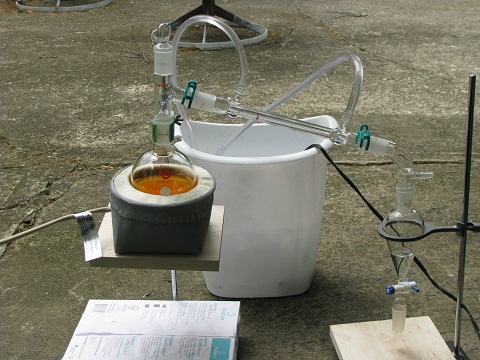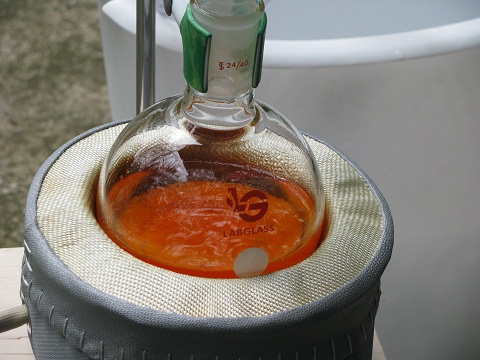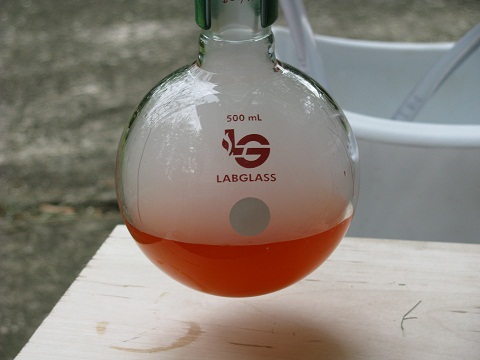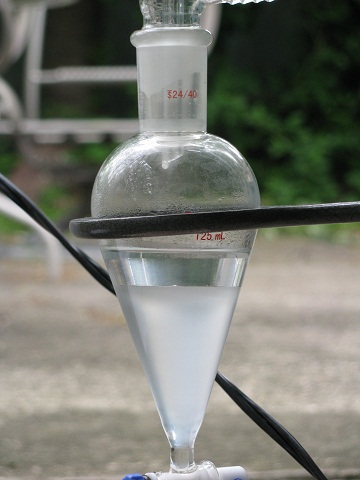| Pages:
1
2
3
4
5 |
Panache
International Hazard
    
Posts: 1290
Registered: 18-10-2007
Member Is Offline
Mood: Instead of being my deliverance, she had a resemblance to a Kat named Frankenstein
|
|
thats a pretty tall column!!
|
|
|
Lambda-Eyde
National Hazard
   
Posts: 860
Registered: 20-11-2008
Location: Norway
Member Is Offline
Mood: Cleaved
|
|
I did a simple distillation of the product today. Passing over from 82 to about 104 degrees celcius was a milky organic liquid and some water. It did
not even have the slightest hint of the dark compound, earlier assumed to be bromine, that was left in the distillation flask. Some passed over from
112 to 124 degrees, which I didn't add together with the other batches for the workup.
The distillate collected at 82-104*C was put in a separatory funnel and separated into two phases: One lower, organic layer with a milky appearance
and a small aqueous phase above.
I'll do the workup and hopefully a final distillation of the product in about an hour. Report with numbers and pictures are to follow later today.
|
|
|
Lambda-Eyde
National Hazard
   
Posts: 860
Registered: 20-11-2008
Location: Norway
Member Is Offline
Mood: Cleaved
|
|
Finally got done with the synthesis today. The result what somewhat disappointing, but not surprising.
Here's the reaction mixture in a separatory funnel after standing over the weekend. Note the large amount of crystals and the dirty upper (!) organic
layer.

A picture of the first distillation setup.

Two of the receiving flasks.

Seems like I forgot to take any more pictures. They wouldn't have been any spectacular anyways.
Before beginning workup of the crude distillates I decided to add the batch that came over at 112-124*C to the total distillate anyways in hope of
extracting any BuBr present.
The distillate was first washed with 100 ml of water, then 100 ml 36% HCl, 100 ml water again, then 100 ml sodium carbonate solution, and 100 ml water
again. This was done according to Vogel's recommended workup method for BuBr synthesis.
To the thoroughly washed organic layer was then added about a teaspoon (I feel like a briton  ) of CaCl<sub>2</sub>. It was dried for about twenty minutes with occasional swirling; no clumping was
observed. It was then filtered straight into a 100 ml round bottom flask and distilled in a dry, clean distillation setup into a 50 ml flask. The
first distillate came over at 99-102*C. The distillation was stopped when the temperature rose to about 110*C, and it was cut off before any of it
could contaminate the previous batch. ) of CaCl<sub>2</sub>. It was dried for about twenty minutes with occasional swirling; no clumping was
observed. It was then filtered straight into a 100 ml round bottom flask and distilled in a dry, clean distillation setup into a 50 ml flask. The
first distillate came over at 99-102*C. The distillation was stopped when the temperature rose to about 110*C, and it was cut off before any of it
could contaminate the previous batch.
The distillate was perfectly clear and didn't smell too strongly. It was vaguely remniscient of methylene chloride, but had a more sickening smell.
Not very sweet.
The distillate occupied 19 ml and weighed in at 23,5 grams, giving a specific gravity of 1,24. This is close enough to the specific gravity of
1-bromobutane; 1,27 (Wikipedia).
The yield, however, was rather lousy. Basing the calculations on the amount of 1-butanol used, 55 ml, or 0,6 moles, gives a yield of 29
%, not very spectacular. Vogel quotes a yield of 95 % for the same synthesis, although at a 2x scale.
I can already see a number of reasons for the bad yield. Firstly, I used equimolar amounts of 1-butanol and HBr (NaBr). I should have used an excess
of NaBr when taking in consideration the losses due to evaporation of HBr during the synthesis and oxidation of the bromide ion. I rushed the
synthesis too much. I was kinda in a hurry when I did it and used much heat and refluxed the reaction mixture for only 70 minutes. The addition of the
sulfuric acid was done all to quickly during the synthesis due to the time strain, causing oxidation of bromide which could be observed. This probably
resulted in some dibutyl ether too.
I had to rush the synthesis somewhat because neither leaving the setup hot nor missing my bus home were options I wished to go for.
[Edited on 11-5-2010 by Lambda-Eyde]
[Edited on 11-5-2010 by Lambda-Eyde]
|
|
|
rrkss
Hazard to Others
  
Posts: 193
Registered: 18-12-2009
Member Is Offline
Mood: No Mood
|
|
Ethyl Bromide
I just ran vanino's prep for ethyl bromide. I ultimately intend to use it in a grignard reaction with ethyl acetate to prepare 3-methyl-3-petanol.
In a 500 mL roundbottom, I added a magnetic stirbar and 38 mL of H2O + 55 mL of 95% ethanol. This flask was submerged in a beaker with icewater and
using an addition funnel I added 55 mL of concentrated H2SO4 with constant magnetic stirring. Upon completion I added 98g of NaBr. The flask turned
orange upon the addition of the NaBr. I setup for simple distillation using a seperatory funnel containing about 20 mL of H2O as a receiver. I
cooled my condenser with Ice Water.

I set my variac to 25% power and started to distill my product.

At the end of the distillation my flask filled up with a white gas (SO2?) and I dropped the mantle at this point.

Here is my seperatory funnel with a cloudy Ethyl Bromide on the bottom layer and H2O on the top.

Next step is a 3 step workup involving a shake with 10% NaOH solution, followed by a shake of 10% Sodium Thiosulfate solution and then a dry on CaCl2
to remove water and any ethanol that might have distilled over. I don't care about any ether as I am using this for a grignard and thus I am
eliminating the concentrated H2SO4 workup described in Vanino.
Will report my yield when I finish the workup.
[Edited on 5-11-10 by rrkss]
|
|
|
rrkss
Hazard to Others
  
Posts: 193
Registered: 18-12-2009
Member Is Offline
Mood: No Mood
|
|
Did a large portion of my workup. The cloudy ethyl bromide turned clear and colorless almost immediately upon the addition of 30 mL of 10% NaOH
solution to the Sep Funnel. I agitated the funnel and drained the lower organic layer into a seperate container. Then after emptying the upper
aqueous layer, I put the organic layer back into the sep funnel and rewashed with 30 mL of sodium thiosulfate solution. The organic layer which
appears to be about 50+ mL was then drained into a 250 mL roundbottom filled with 10 grams of anhydrous CaCl2. It is sitting outside overnight in
this flask to ensure good drying but so far, I see no clumping of the CaCl2.
|
|
|
rrkss
Hazard to Others
  
Posts: 193
Registered: 18-12-2009
Member Is Offline
Mood: No Mood
|
|
Done with my workup. I got 52.54g of product after distillation or a 48% yield. Not a great yield but the product seems to be very pure. The
boiling point range during the simple distillation from CaCl2 was 38.5 - 39.0 degrees which is very narrow and very close to the literature value of
38.4 degrees.
|
|
|
redox
Hazard to Others
  
Posts: 268
Registered: 22-2-2011
Location: The Land of Milk and Honey
Member Is Offline
Mood: Chalcogenetic
|
|
I performed the bromethane synthesis about two weeks ago, and as of now it has all evaporated. It turns out my bottle didn't have a good seal. Damn!

[Edited on 12-6-2011 by redox]
My quite small but growing Youtube Channel: http://www.youtube.com/user/RealChemLabs
Newest video: Synthesis of Chloroform
The difference between chemists and chemical engineers: Chemists use test tubes, chemical engineers use buckets. |
|
|
spong
Hazard to Others
  
Posts: 128
Registered: 28-5-2009
Location: Chatham
Member Is Offline
Mood: No Mood
|
|
The same happened to my EtBr even though the bottle had a seal  I wouldn't store
it unless the bottle has a pretty hefty cap/seal, the seal on mine was a normal seal coated in teflon tape because I was worried about it dissolving
the seal. I'll use all of it next time I make it, EtBr isn't something I want leaking into the air, even if it does smell awesome I wouldn't store
it unless the bottle has a pretty hefty cap/seal, the seal on mine was a normal seal coated in teflon tape because I was worried about it dissolving
the seal. I'll use all of it next time I make it, EtBr isn't something I want leaking into the air, even if it does smell awesome 
|
|
|
redox
Hazard to Others
  
Posts: 268
Registered: 22-2-2011
Location: The Land of Milk and Honey
Member Is Offline
Mood: Chalcogenetic
|
|
You like the smell of bromoethane? It smells odd/bad to me.
My quite small but growing Youtube Channel: http://www.youtube.com/user/RealChemLabs
Newest video: Synthesis of Chloroform
The difference between chemists and chemical engineers: Chemists use test tubes, chemical engineers use buckets. |
|
|
smuv
National Hazard
   
Posts: 842
Registered: 2-5-2007
Member Is Offline
Mood: Jingoistic
|
|
Store it under a layer of water.
"Titanium tetrachloride…You sly temptress." --Walter Bishop
|
|
|
redox
Hazard to Others
  
Posts: 268
Registered: 22-2-2011
Location: The Land of Milk and Honey
Member Is Offline
Mood: Chalcogenetic
|
|
I find storing under water doesn't work well. It still has a vapor pressure under water, doesn't it?
Anyway, I now store my freshly made bromoethane inside of one of these bottles:
http://www.eandkscientific.com/product.php?productid=31329&a...
The smallest one on the right.
I also wrap teflon tape on the threads and sealing tape around the cap.
My quite small but growing Youtube Channel: http://www.youtube.com/user/RealChemLabs
Newest video: Synthesis of Chloroform
The difference between chemists and chemical engineers: Chemists use test tubes, chemical engineers use buckets. |
|
|
bahamuth
Hazard to Others
  
Posts: 384
Registered: 3-11-2009
Location: Norway
Member Is Offline
Mood: Under stimulated
|
|
Haloalkanes should be stored dry in my experiance, makes it so much easier to use is one thing.
Usually store them with a piece of silver wool or precipitate copper powder (after prolonged drying with CaCl2 and redistillation) to capture any free
halognes, atleast the alkyl iodides (which is all those I have), as I have seen heavy decomposition if left without silver or copper metal for
prolonged periodes, even as I store them at -20 all the time.
Any sufficiently advanced technology is indistinguishable from magic.
|
|
|
redox
Hazard to Others
  
Posts: 268
Registered: 22-2-2011
Location: The Land of Milk and Honey
Member Is Offline
Mood: Chalcogenetic
|
|
Quote: Originally posted by bahamuth  | Haloalkanes should be stored dry in my experiance, makes it so much easier to use is one thing.
Usually store them with a piece of silver wool or precipitate copper powder (after prolonged drying with CaCl2 and redistillation) to capture any free
halognes, atleast the alkyl iodides (which is all those I have), as I have seen heavy decomposition if left without silver or copper metal for
prolonged periodes, even as I store them at -20 all the time. |
This seems wise. My collection of alkyl halides (bromoethane, 1-bromopropane, 2-bromopropane, 1-bromobutane) are obviously all bromides, and I have
found that they don't decompose very much. I plan to make some iodides by the finklestein reaction sometime in the near future.
My quite small but growing Youtube Channel: http://www.youtube.com/user/RealChemLabs
Newest video: Synthesis of Chloroform
The difference between chemists and chemical engineers: Chemists use test tubes, chemical engineers use buckets. |
|
|
spong
Hazard to Others
  
Posts: 128
Registered: 28-5-2009
Location: Chatham
Member Is Offline
Mood: No Mood
|
|
Ohh it smells so sweet! Like the sweet smell from methanol or chloroform but stronger.
|
|
|
redox
Hazard to Others
  
Posts: 268
Registered: 22-2-2011
Location: The Land of Milk and Honey
Member Is Offline
Mood: Chalcogenetic
|
|
I love the smell of chloroform, but I cannot smell methanol. Bromoethane does smell sweet, but an overpowering, acrid kind of sweet.
My quite small but growing Youtube Channel: http://www.youtube.com/user/RealChemLabs
Newest video: Synthesis of Chloroform
The difference between chemists and chemical engineers: Chemists use test tubes, chemical engineers use buckets. |
|
|
Hazel
Harmless

Posts: 1
Registered: 27-4-2009
Member Is Offline
Mood: No Mood
|
|
Hi, small question: could allyl alcohol be successfully substituted for those alkyl alcohols?
Thanks.
|
|
|
Cloner
Hazard to Others
  
Posts: 150
Registered: 7-12-2004
Member Is Offline
Mood: apocalyptic
|
|
It has been described as high yielding and succesful. (http://www.erowid.org/archive/rhodium/chemistry/tcboe/chapte...)
[Edited on 7-7-2011 by Cloner]
|
|
|
Dr.Bob
International Hazard
    
Posts: 2799
Registered: 26-1-2011
Location: USA - NC
Member Is Offline
Mood: Mildly disgruntled scientist
|
|
For those interested in preparing alkyl halides, the father of some of this chemistry was Max Gergal, who wrote a great book about his company,
Columbia Organics, which is hard to find, but sometime available via Amazon or other sources. He describes some of his experiences making them along
with the joys or running a small company. It's a hoot.
http://www.amazon.com/Excuse-Would-Like-Isopropyl-Bromide/dp...
|
|
|
Thor
Harmless

Posts: 19
Registered: 13-6-2011
Member Is Offline
Mood: No Mood
|
|
There is a copy in the forum library, a really great read.
|
|
|
rodanid88
Harmless

Posts: 4
Registered: 16-7-2012
Member Is Offline
Mood: No Mood
|
|
I tried to synthesize BuCl from BuOH, 32% HCl and 96% H2SO4. At the end of the distillation i got black tarry remainder in the RBF. Anyway the yield
was very low (~30%), but it is not the main problem, because the process was not the best. I can only imagine that the H2SO4 was not pure enough.
Thanks
|
|
|
Magpie
lab constructor
    
Posts: 5939
Registered: 1-11-2003
Location: USA
Member Is Offline
Mood: Chemistry: the subtle science.
|
|
I was just reading about this. For the conversion of primary alcohols to alkyl halides use of PX3 is usually recommended. The yields are much higher
than with HX acids. There are no rearrangements with the PX3.
When making alkyl iodides formation of the PI3 in situ from P and I2 is recommended due to instability of PI3.
ref: Bruice's textbook
The single most important condition for a successful synthesis is good mixing - Nicodem
|
|
|
Heuteufel
Harmless

Posts: 25
Registered: 5-11-2011
Member Is Offline
Mood: No Mood
|
|
I did the synthesis of 1-Bromobutane recently: Synthesis of 1-Bromobutane
The yield was 63 %, which is not astonishing, but the product is quite pure as a Grignard I performed with it started very readily. In my opinion the
washing with (a sufficient amount!) of concentrated sulfuric acid is very important. If it is ommited, the yield may seem high, but the product is
impure and useless for most reactions.
|
|
|
gsd
National Hazard
   
Posts: 847
Registered: 18-8-2005
Member Is Offline
Mood: No Mood
|
|
Quote: Originally posted by rodanid88  | I tried to synthesize BuCl from BuOH, 32% HCl and 96% H2SO4. At the end of the distillation i got black tarry remainder in the RBF. Anyway the yield
was very low (~30%), but it is not the main problem, because the process was not the best. I can only imagine that the H2SO4 was not pure enough.
Thanks |
The procedure for making alkyl chlorides is different from that of bromides.
Procedure for Preparation of n-Butyl Chloride
http://www.orgsyn.org/orgsyn/pdfs/CV1P0142.pdf
gsd
|
|
|
UnintentionalChaos
International Hazard
    
Posts: 1454
Registered: 9-12-2006
Location: Mars
Member Is Offline
Mood: Nucleophilic
|
|
I ran a prep of Ethyl Bromide today based on the orgsyn.org prep (http://www.orgsyn.org/orgsyn/orgsyn/prepcontent.asp?prep=cv1...)
Instead of HBr, I substituted NaBr with excess H2SO4. A 1L RBF was charged with 241ml of 80 proof vodka (equivalent to 1.65mol of anhydrous ethanol).
With stirring, 154.34g of NaBr (1.5mol) was added. A standard distillation apparatus was assembled with ice water supplied to the condenser and the
recieving flask (250ml) sitting in an ice-salt bath. In place of a thermometer adapter, a pressure-equalizing addition funnel was added containing
330g of ~92% drain cleaner sulfuric acid (~3.1mol). This was slowly added to the ethanol/water/NaBr mixture with occasional cooling by an ice bath. A
lot of fumes were produced in the flask initially, but did not pass over into the condenser. The reaction mixture became fairly warm and turned
orange, but no distillate formed. A considerable amount of NaHSO4 was formed, but the stirring was able to keep it in suspension.
After the sulfuric acid addition was complete, the addition funnel was replaced with a thermometer adapter. Distillation was carried out on a fairly
low heat setting (3 on my Corning PC-351). The upper portion of the flask was insulated with a sheet of aluminium foil since the ambient temperature
was fairly low. Distillate initially came over fairly rapidly in the low 40C range. When flow slowed, the heat was gradually increased to 4.
Distillate came over in the 40-50C range for 3 1/2 hours. Heat was increased to 5 when the stillhead temp was near 55C. Distillate (showing droplets
of an organic phase) continued to be collected up until the stillhead reached 80C and flow came essentially to a halt.
The distillate consisted of a large organic phase with a thin aqueous phase on top. The entire contents was transferred to a 250ml sep funnel and
washed with about 40ml of ice cold saturated sodium bicarbonate solution containing a very small amount of sodium sulfite. No apparent CO2 was formed
on shaking indicating absolutely minimal or no HBr contamination. This wash should be considered extraneous or be replaced with a wash of ice cold
distilled H2O.
The organic phase was removed, the funnel cleaned and dried, and the organic phase returned to it. 30g of concentrated H2SO4 was added and shaken with
the EtBr repeatedly. This caused an unusual faint cloudiness in the organic phase which split light and made it very colorful when illuminated.
The lower H2SO4 layer was drained off and the organic phase was immediately washed with a large portion of ice-cold saturated sodium bicarbonate
solution. Initial CO2 release is dramatic from H2SO4 adhering to the sep funnel's walls. Agressive shaking and venting is needed to expel CO2 from
solution. When the upper aqueous phase still produces bubbles with some dilute acid, enough NaHCO3 has been used.
The lower phase was drained into an RB flask and dried over CaCl2 for a few hours. The dry product weighed 147.54g (1.35mol), a 90% yield from NaBr.
[Edited on 11-16-12 by UnintentionalChaos]
Department of Redundancy Department - Now with paperwork!
'In organic synthesis, we call decomposition products "crap", however this is not a IUPAC approved nomenclature.' -Nicodem
|
|
|
chucknorris
Hazard to Self
 
Posts: 57
Registered: 13-4-2012
Member Is Offline
Mood: No Mood
|
|
Can you do this process non-stop by mixing the goods beforehead and then continuously flowing them into the reactor and distill over crude
bromoethane?
|
|
|
| Pages:
1
2
3
4
5 |